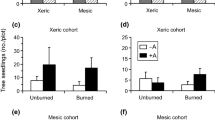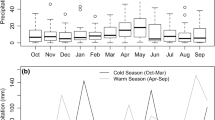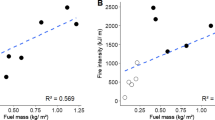Abstract
This paper reports the findings of a short-term natural invasibility field study in constructed Mediterranean herbaceous communities of varying diversities, under a fire treatment. Three components of invasibility, i.e. species richness, density and biomass of invaders, have been monitored in burnt and unburnt experimental plots with resident diversity ranging from monocultures to 18-species mixtures. In general, species richness, density and biomass of invaders decreased significantly with the increase of resident species richness. Furthermore, the density and biomass of invading species were significantly influenced by the species composition of resident communities. Although aboveground biomass, leaf area index, canopy height and percent bare ground of the resident communities explained a significant part of the variation in the success of invading species, these covariates did not fully explain the effects of resident species richness. Fire mainly influenced invasibility via soil nutrient levels. The effect of fire on observed invasibility patterns seems to be less important than the effects of resident species richness. Our results demonstrate the importance of species richness and composition in controlling the initial stages of plant invasions in Mediterranean grasslands but that there was a lack of interaction with the effects of fire disturbance.

Similar content being viewed by others
References
Allen SE (ed) (1989) Chemical analysis of ecological materials, 2nd edn. Blackwell, Oxford
Allison GW (1999) The implication of experimental design for biodiversity manipulations. Am Nat 153:26–45
Arianoutsou M (1998) Aspects of demography in post-fire Mediterranean plant communities of Greece. In: Rundel PW, Montengero G, Jacksic FM (eds) Landscape degradation and biodiversity in Mediterranean-type ecosystems. Ecological studies, vol 136. Springer, Berlin Heidelberg New York, pp 273–295
Burke MJW, Grime JP (1996) An experimental study of plant community invasibility. Ecology 77:776–790
Chapin FS et al. (2000) Consequences of changing biotic diversity. Nature 405:234–242
Crawley MJ (1987) What makes a community invasible? In: Gray AJ, Crawley MJ, Edwards PJ (eds) Colonization, succession and invasions. Blackwell, Oxford, pp 429–454
Crawley MJ, Brown SL, Heard MS, Edwards R (1999) Invasion-resistance in experimental grassland communities: species richness or species identity? Ecol Lett 2:140–148
Davis MA, Grime JP, Thompson K (2000) Fluctuating resources in plant communities: a general theory of invasibility. J Ecol 88:528–534
Diemer M, Schmid B (2001) Effects of biodiversity loss and disturbance on the survival and performance of two Ranunculus species with differing clonal architectures. Ecography 24:59–67
Diemer M, Joshi J, Körner Ch, Schmid B, Spehn E (1997) An experimental protocol to assess the effects of plant diversity on ecosystem functioning utilized in a European research network. Bull Geobot Inst ETH 63:95–107
Dimitrakopoulos PG (2001) Interactive effects of fire and diversity on ecosystem functioning in experimental Mediterranean grassland communities: testing the insurance hypothesis. PhD Thesis, University of the Aegean
Dukes JS (2001) Diversity and invasibility in grassland microcosms. Oecologia 126:563–568
Dukes JS (2002) Species composition and diversity affect grassland susceptibility to invasion. Ecol Appl 12:602–617
Elton CS (1958) The ecology of invasions by animals and plants. Methuen, London
Fargione J, Brown CS, Tilman D (2003) Community assembly and invasion: an experimental test of neutral versus niche properties. Proc Natl Acad Sci USA 100:8916–8920
Hector A et al (1999) Plant diversity and productivity experiments in European grasslands. Science 286:1123–1127
Hector A, Dobson K, Minns A, Bazeley-White E, Lawton JH (2001) Community diversity and invasion resistance: an experimental test in a grassland ecosystem and a review of comparable studies. Ecol Res 16:819–831
Hobbs RJ, Huenneke LF (1992) Disturbance, diversity and invasion: implication for conservation. Conserv Biol 6:324–337
Joshi J, Matthies D, Schmid B (2000) Root hemiparasites and plant diversity in experimental grassland communities. J Ecol 88:634–644
Keeley JE (2001) Fire and invasive species in Mediterranean-climate ecosystems of California. In: Galley KEM, Wilson TP (eds) Proceedings of the invasive species workshop: the role of fire in the control and spread of invasive species. Fire conference 2000: the first National congress on fire ecology, prevention, and management. Miscellaneous Publication No. 11. Tall Timbers Research Station, Tallahassee, pp 81–94
Keeley JE, Lubin D, Fortheringham CJ (2003) Fire and grazing impacts on plant diversity and alien plant invasion in the southern Sierra Nevada. Ecol Appl 13:1355–1374
Kennedy TA, Naeem S, Howe KM, Knops JMH, Tilman D, Reich P (2002) Biodiversity as a barrier to ecological invasion. Nature 417:636–638
Kinzig A, Pacala S, Tilman DA (eds) (2002) The functional consequences of biodiversity. Princeton University Press, Princeton
Knops JMH et al. (1999) Effects of plant species richness on invasion dynamics, disease outbreaks, insect abundance and diversity. Ecol Lett 2:286–294
Lavorel S, Canadell J, Rambal S, Terradas J (1998) Mediterranean terrestrial ecosystems: research priorities on global change effects. Global Ecol Biogeogr Lett 7:157–166
Lavorel S, Prieur-Richard A-H, Grigoulis K (1999) Invasibility and diversity of plant communities: from plant to processes. Divers Distrib 5:41–49
Levine JM (2000) Species diversity and biological invasions: relating local process to community pattern. Science 288:852–854
Levine JM, D’Antonio CM (1999) Elton revisited: a review of evidence linking diversity and invasibility. Oikos 87:15–26
Levine JM, Kennedy T, Naeem S (2002) Neighbourhood scale effects of species diversity on biological invasions and their relationship to community patterns. In: Loreau M, Naeem S, Inchausti P (eds) Biodiversity and ecosystem functioning: synthesis and perspectives. Oxford University Press, Oxford, pp 114–124
Loreau M, Hector A (2001) Partitioning selection and complementarity in biodiversity experiments Nature 412:72–76 (Erratum: Nature 413:548)
Loreau M., Naeem S, Inchausti P (eds) (2002a) Biodiversity and ecosystem functioning: synthesis and perspectives. Oxford University Press, Oxford
Loreau M et al. (2002b) A new look at the relationship between diversity and stability. In: Loreau M, Naeem S, Inchausti P (eds) Biodiversity and ecosystem functioning: synthesis and perspectives. Oxford University Press, Oxford, pp 79–91
Lyons KG, Schwartz MW (2001) Rare species loss alters ecosystem function-invasion resistance. Ecol Lett 4:358–365
Mack RN, Simberloff D, Lonsdale WM, Evans H, Clout M, Bazzaz FA (2000) Biotic invasions: causes, epidemiology, global consequences, and control. Ecol Appl 10:689–710
Meiners SJ, Cadenasso ML, Pickett STA (2004) Beyond biodiversity: individualistic controls of invasion in a self-assembled community. Ecol Lett 7:121–126
Memtsas D, Dimitrakopoulos PG, Siamantziouras A-SD, Troumbis AY (2002) Changes in structure and function in response to changing diversity within Mediterranean grassland communities. Ecol Mediterr 28:5–18
Naeem S, Knops JMH, Tilman D, Howe KM, Kennedy T, Gale S (2000) Plant diversity increases resistance to invasion in the absence of covarying extrinsic factors. Oikos 91:97–108
Neter J, Wasserman W (1974) Applied linear statistical models. Richard D. Irwin, Homewood
Noy-Meir I (1995) Interactive effects of fire and grazing on structure and diversity of Mediterranean grasslands. J Veg Sci 6:701–710
Palmer MW, Maurer T (1997) Does diversity beget diversity? A case study of crops and weeds. J Veg Sci 8:235–240
Prieur-Richard A-H, Lavorel S (2000) Invasions: the perspective of diverse plant communities. Austral Ecol 25:1–7
Prieur-Richard A-H, Lavorel S, Grigulis K, Dos Santos A (2000) Plant community diversity and invasibility by exotics: invasion of Mediterranean old fields by Conyza bonariensis and Conyza canadensis. Ecol Lett 3:412–422
Prieur-Richard A-H, Lavorel S, Linhart YB, Dos Santos A (2002a) Plant diversity, herbivory and resistance of a plant community to invasion in annual communities. Oecologia 130:96–104
Prieur-Richard A-H, Lavorel S, Dos Santos A, Grigulis K (2002b) Mechanisms of resistance of Mediterranean annual communities to invasion by Conyza bonariensis: effects of native functional composition. Oikos 99:338–346
van der Putten WH et al. (2000) Plant species diversity as a driver of early succession in abandoned fields: a multi-site approach. Oecologia 124:91–99
van Ruijven J, De Deyn GB, Berendse F (2003) Diversity reduces invasibility in experimental plant communities: the role of plant species. Ecol Lett 6:910–918
Sala OE et al. (2000) Global biodiversity scenarios for the year 2100. Science 287:1770–1774
Smith MD, Knapp AK (1999) Exotic plant species in a C4-dominated grassland: invasibility, disturbance, and community structure. Oecologia 120:605–612
Smith MD, Knapp AK (2001) Size of the local species pool determines invasibility of a C4-dominated grassland. Oikos 92:55–61
Spehn EM et al. (2002) The role of legumes as a component of biodiversity in a cross-European study of grassland biomass nitrogen. Oikos 98:205–218
Stohlgreen TJ, Chong GW, Schell LD, Rimar KA, Otsuki Y, Lee M, Kalkhan MA, Villa CA (2002) Assessing vulnerability to invasion by nonnative plant species at multiple spatial scales. Environ Manage 29:566–577
Stohlgreen TJ, Barnett DT, Kartesz JT (2003) The rich get richer: patterns of plant invasion in the United States. Front Ecol Environm 1:11–14
Symstad A (2000) A test of the effects of functional group richness and composition on grassland invasibility. Ecology 81:99–109
Thompson K, Hodgson JD, Grime JP, Burke MJW (2001) Plant traits and temporal scale: evidence from a 5-year invasion experiment using native species. J Ecol 89:1054–1060
Tilman D (1997) Community invasibility, recruitment limitation, and grassland biodiversity. Ecology 78:81–92
Trabaud L (1990) Fire as an agent of plant invasion? A case study in the French Mediterranean vegetation. In: di Castri F, Hansen AJ, Debussche M (eds) Biological invasions in Europe and Mediterranean Basin. Kluwer, Dordrecht, pp 417–437
Trabaud L (1994) Post-fire community dynamics in the Mediterranean Basin. In: Moreno JM, Oechel WC (eds) The role of fire in Mediterranean-type ecosystems. Ecological studies, vol 107. Springer, Berlin Heidelberg New York, pp 1–15
Trabaud L, Lepart J (1981) Changes in floristic composition of a Quercus coccifera L. garrigue in relation to different fire regimes. Vegetatio 46:105–116
Trabaud L, Prodon R (2002) Fire and biological processes. Backhuys, Leiden
Troumbis AY, Dimitrakopoulos PG, Siamantziouras A-SD, Memtsas D (2000) Hidden diversity and productivity patterns in mixed Mediterranean grasslands. Oikos 90:549–559
Troumbis AY, Galanidis A, Kokkoris GD (2002) Components of short-term invasibility in experimental Mediterranean grasslands. Oikos 98:239–250
Wardle DA (2001) Experimental demonstration that plant diversity reduces invasibility: evidence of a biological mechanism or a consequence of sampling effect? Oikos 95:161–170
Acknowledgements
We wish to thank all the people that helped with the weeding of the plots, T. Akriotis for the linguistic editing of the manuscript, B. Schmid for his advice in statistical analysis and continuous scientific support, T. Akriotis and three anonymous referees for their constructive comments on a previous version of the manuscript. This work was partially supported by EU-funded BIODEPTH project (ENV-CT95-0008).
Author information
Authors and Affiliations
Corresponding author
Rights and permissions
About this article
Cite this article
Dimitrakopoulos, P.G., Galanidis, A., Siamantziouras, AS.D. et al. Short-term invasibility patterns in burnt and unburnt experimental Mediterranean grassland communities of varying diversities. Oecologia 143, 428–437 (2005). https://doi.org/10.1007/s00442-004-1808-8
Received:
Accepted:
Published:
Issue Date:
DOI: https://doi.org/10.1007/s00442-004-1808-8




